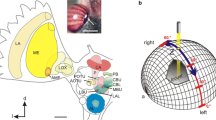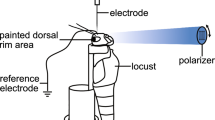Abstract
Many insects can detect the polarization pattern of the blue sky and rely on polarization vision for sky compass orientation. In laboratory experiments, tethered flying locusts perform periodic changes in flight behavior under a slowly rotating polarizer even if one eye is painted black. Anatomical tracing studies and intracellular recordings have suggested that the polarization vision pathway in the locust brain involves the anterior optic tract and tubercle, the lateral accessory lobe, and the central complex of the brain. To investigate whether visual pathways through the anterior optic tract mediate polarotaxis in the desert locust, we transected the tract on one side and tested polarotaxis (1) with both eyes unoccluded and (2) with the eye of the intact hemisphere painted black. In the second group of animals, but not in the first group, polarotaxis was abolished. Sham operations did not impair polarotaxis. The experiments show that the anterior optic tract is an indispensable part of visual pathways mediating polarotaxis in the desert locust.






Similar content being viewed by others
Abbreviations
- AOT:
-
Anterior optic tract
- AOTu:
-
Anterior optic tubercle
- DRA:
-
Dorsal rim area
- FFT:
-
Fast Fourier transform
- LD:
-
Light–dark
- PAP:
-
Peroxidase–antiperoxidase
- POT:
-
Posterior optic tract
- POTu:
-
Posterior optic tubercle
References
Brunner D, Labhart T (1987) Behavioural evidence for polarization vision in crickets. Physiol Entomol 12:1–10
Dacke M, Nordström P, Scholtz C (2003) Twilight orientation to polarised light in the crepuscular dung beetle Scarabaeus zambesianus. J Exp Biol 206:1535–1543
von Frisch K (1949) Die Polarisation des Himmelslichtes als orientierender Faktor bei den Tänzen der Bienen. Experientia 5:142–148
Gewecke M (1975) The influence of the air-current sense organs on the flight behaviour of Locusta migratoria. J Comp Physiol 103:79–95
Hausen K, Wehrhahn C (1983) Microsurgical lesion of horizontal cells changes optomotor yaw responses in the blowfly Calliphora erythrocephala. Proc R Soc Lond B 219:211–216
Heinze S, Homberg U (2005) A new set of tangential neurons of the protocerebral bridge in the desert locust Schistocerca gregaria is sensitive to polarized light. 98. Annual meeting of the DZG, Bayreuth, p 73. http://www.uni-bayreuth.de/dzg-gebin2005
Hofer S, Dircksen H, Tollbäck P, Homberg U (2005) Novel insect orcokinins: characterization and neuronal distribution in the brains of selected dicondylian insects. J Comp Neurol 490:57–71
Homberg U (1991) Neuroarchitecture of the central complex in the brain of the locust Schistocerca gregaria and S. americana as revealed by serotonin immunocytochemistry. J Comp Neurol 303:245–254
Homberg U (2004) In search of the sky compass in the insect brain. Naturwissenschaften 91:199–208
Homberg U, Heinze S (2006) A computational map of e-vector orientations in the central complex of the desert locust (Schistocerca gregaria). FENS Abstr 3:A129.9
Homberg U, Würden S (1997) Movement-sensitive, polarization-sensitive, and light-sensitive neurons of the medulla and accessory medulla of the locust, Schistocerca gregaria. J Comp Neurol 386:329–346
Homberg U, Hofer S, Pfeiffer K, Gebhardt S (2003a) Organization and neural connections of the anterior optic tubercle in the brain of the locust, Schistocerca gregaria. J Comp Neurol 462:415–430
Homberg U, Reischig T, Stengl M (2003b) Neural organization of the circadian system of the cockroach Leucophaea maderae. Chronobiol Int 20:577–591
Labhart T, Meyer EP (1999) Detectors for polarized skylight in insects: a survey of ommatidial specializations in the dorsal rim area of the compound eye. Microsc Res Tech 47:368–379
Labhart T, Meyer EP (2002) Neural mechanisms in insect navigation: polarization compass and odometer. Curr Opin Neurobiol 12:707–714
Liu G, Seiler H, Wen A, Zars T, Ito K, Wolf R, Heisenberg M, Liu L (2006) Distinct memory traces for two visual features in the Drosophila brain. Nature 439:551–556
Mappes M, Homberg U (2004) Behavioral analysis of polarization vision in tethered flying locusts. J Comp Physiol A 190:61–68
Pfeiffer K, Kinoshita M, Homberg U (2005) Polarization-sensitive and light-sensitive neurons in two parallel pathways passing through the anterior optic tubercle in the locust brain. J Neurophysiol 94:3903–3915
von Philipsborn A, Labhart T (1990) A behavioral study of polarization vision in the fly, Musca domestica. J Comp Physiol A 167:737–743
Preiss R, Gewecke M (1991) Compensation of visually simulated wind drift in the swarming flight of the desert locust (Schistocerca gregaria). J Exp Biol 157:461–481
Rossel S, Wehner R (1986) Polarization vision in bees. Nature 323:128–131
Sakura M, Labhart T (2005) Polarization-sensitive neurons in the central complex of the cricket, Gryllus bimaculatus. Neuroforum (Suppl):154B
Sauman I, Briscoe AD, Zhu H, Shi D, Froy O, Stalleicken J, Yuan Q, Casselman A, Reppert SM (2005) Connecting the navigational clock to sun compass input in monarch butterfly brain. Neuron 46:457–467
Stalleicken J, Mukhida M, Labhart T, Wehner R, Frost B, Mouritsen M (2005) Do monarch butterflies use polarized skylight for migratory orientation? J Exp Biol 208:2399–2408
Sternberger LA (1979) Immunocytochemistry.Wiley, New York
Strauss R (2002) The central complex and the genetic dissection of locomotor behaviour. Curr Opin Neurobiol 12:633–638
Vitzthum H, Homberg U (1998) Immunocytochemical demonstration of locustatachykinin-related peptides in the central complex of the locust brain. J Comp Neurol 390:455–469
Vitzthum H, Müller M, Homberg U (2002) Neurons of the central complex of the locust Schistocerca gregaria are sensitive to polarized light. J Neurosci 22:1114–1125
Wehner R (2003) Desert ant navigation: how miniature brains solve complex tasks. J Comp Physiol A 189:579–588
Acknowledgments
We thank Bianca Backasch and Iris Friedrich for assistance with the control experiments, Dr. Hans Agricola for the anti-Lom-TK II antiserum, and Drs. Michael Gewecke and Reinhard Preiss for providing the wind tunnel and yaw-torque meter. We are very grateful to Miriam Henze (University of Zurich), Sascha Gotthardt (MPI for Brain Research, Frankfurt), Stanley Heinze and Keram Pfeiffer (both University of Marburg) for valuable suggestions on the FFT. All experiments comply with the “Principles of animal care”, publication No. 86-23, revised 1985 of the National Institute of Health and with the German Animal Protection Law. This research was supported by DFG grant HO 950/16-1.
Author information
Authors and Affiliations
Corresponding author
Rights and permissions
About this article
Cite this article
Mappes, M., Homberg, U. Surgical lesion of the anterior optic tract abolishes polarotaxis in tethered flying locusts, Schistocerca gregaria . J Comp Physiol A 193, 43–50 (2007). https://doi.org/10.1007/s00359-006-0166-x
Received:
Revised:
Accepted:
Published:
Issue Date:
DOI: https://doi.org/10.1007/s00359-006-0166-x




